8C1 Mathematics
Section outline
-
Kia ora 8C1. No school this week due to the government's announcement to keep schools closed due to the Flooding.
There are the things happening this week:
Admin Day conferences
Touching base with parents and students
LA introduction to Yr 7 parents and students, initial checklist
DEEP Selections - Students start looking at options
GATE programme letters to identified students and parents
-
Kia ora 8C1.
I am very excited to finally see you! This week we will start to refresh your basic skills and refresh your knowledge on fractions.
Success Criteria: I can/have...
- learnt maths facts about Mrs Priest
- taken part in Numeracy Ninja Do Now
- completed the Education Perfect tasks
- find fractions equivalent to the one given
- find fractions of a quantity
- add and subtract fractions
- compare fractions
Activities:
- Numeracy Ninja - Do Now
- Education Perfect
- Online Warm Up https://www.transum.org/Maths/Activity/Beat_The_Clock/
- Online practice for finding equivalent fractions - https://www.transum.org/Maths/Activity/Fractions/Equivalent.asp?Level=3
- Simplifying fractions
- Video on simplifying fractions - https://www.youtube.com/watch?v=aNQXhknSwrI
- Finding fraction of a quantity
- Video on finding the fraction of a quantity - https://www.youtube.com/watch?v=ZF5Viuwo1bw
- Adding and subtracting fractions with same and different denominators
- Video on adding and subtracting fractions - https://www.youtube.com/watch?v=XsW8HJutIgM
Homework:
finish off tasks from classEXPLORE / TŪHURA learning intentions:
- We are EXPLORING equivalent fractions
- We are EXPLORING finding the fraction of a quantity
-
Kia ora students and welcome to Term 1 Week 3.
Success Criteria: I can/have...
- taken part in Numeracy Ninja Do Now
- completed the Education Perfect tasks by Thursday
- find fractions equivalent to the one given
- find fractions of a quantity
- add and subtract fractions
- compare fractions
Activities:
- Numeracy Ninja - Do Now
- Education Perfect due Thursday
- Ludi Basic Facts
- Kahoot and Blooket on Factions
- Online practice for finding equivalent fractions - https://www.transum.org/Maths/Activity/Fractions/Equivalent.asp?Level=3
- Video on simplifying fractions - https://www.youtube.com/watch?v=aNQXhknSwrI
- Video on finding the fraction of a quantity - https://www.youtube.com/watch?v=ZF5Viuwo1bw
- Video on adding and subtracting fractions - https://www.youtube.com/watch?v=XsW8HJutIgM
- Extension practise tasks below
Homework:
Maths Buddy - due FridayFRACTION VOCABULARY
Fraction – A fraction is a part of a collection, set or a whole.
Numerator – Numerator is the number or digits placed above the bar in a fraction, it represents how many equal parts of the whole are indicated.
Denominator – Denominator is the number or digits placed below the bar in a fraction. It represents how many equal parts are present in the whole.
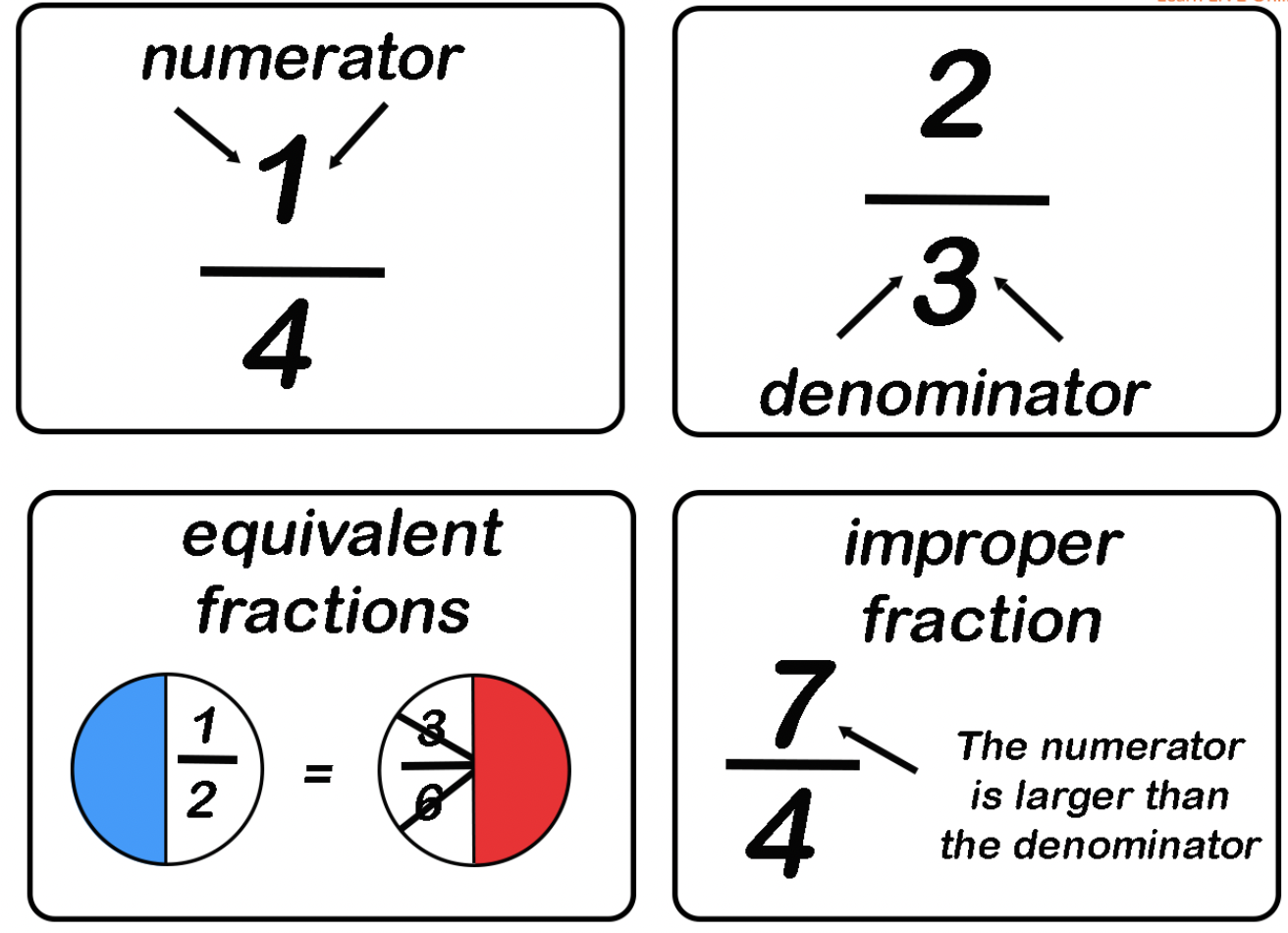
4. Proper fraction – A proper fraction is a type of fraction where the numerator is less than the denominator, less than a whole
5. Improper fraction – An improper fraction is a type fraction where the numerator is greater than the denominator, greater than a whole
6. Equivalent fraction – Equivalent fraction is fractions that give equal fraction values. Hence equivalent fractions that name the same amount.
7. Mixed fraction - A fraction represented with its quotient and remainder is a mixed fraction. For example, 2 1/3 is a mixed fraction, where 2 is the quotient, 1 is the remainder. So, a mixed fraction is a combination of a whole number and a proper fraction.
-
TERM 1 WEEK 4
Success Criteria: I can/have...
- State what 'Percent' means
- Write fractions as percentages by making the denominator 100
- Convert fractions and decimals into percentages and vice versa
Activities:
- Numeracy Ninja - Do Now
- Fraction puzzle - https://www.transum.org/Maths/Puzzles/Circumfraction/ or https://www.transum.org/Maths/Activity/Fractions/Fickle.asp
- Warm up - https://www.transum.org/Maths/Puzzles/Riddles/Diophantus.asp
- Explanation of skills and concepts with examples
- Meaning of percent
- Percentages in every day life/common percentages
- Expressing a fraction and decimal number as a percentage and vice versa
- Converting between fractions, decimals and percentages
- MHOL Practice
- Contextual problems (Extension)
Homework:
Maths Buddy (Differentiation)
EXPLORE / TŪHURA learning intentions:
- We are EXPLORING understanding and recognising percentages in everyday life.
- We are EXPLORING finding ways to express a fraction and a decimal as a percentage and vice versa.
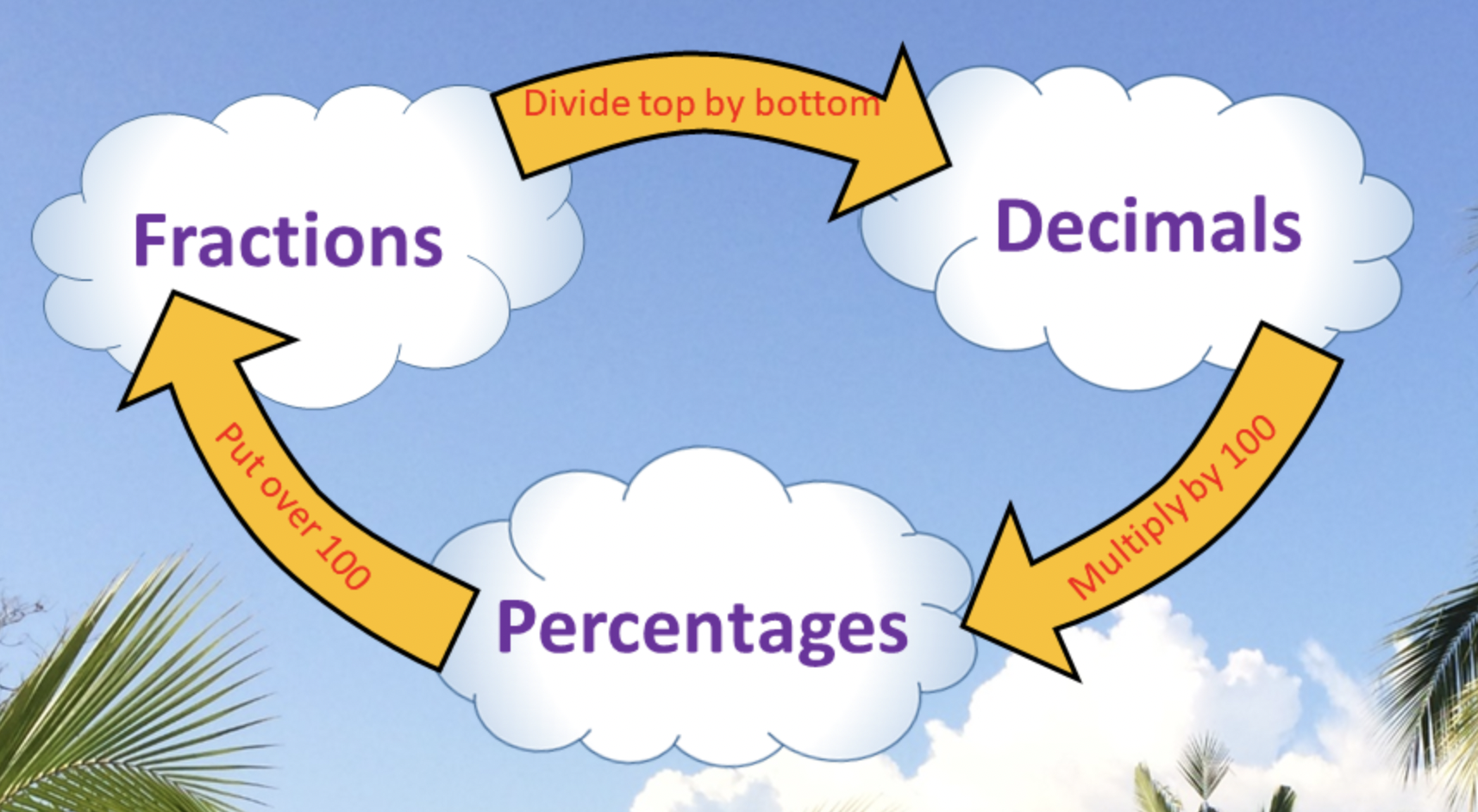
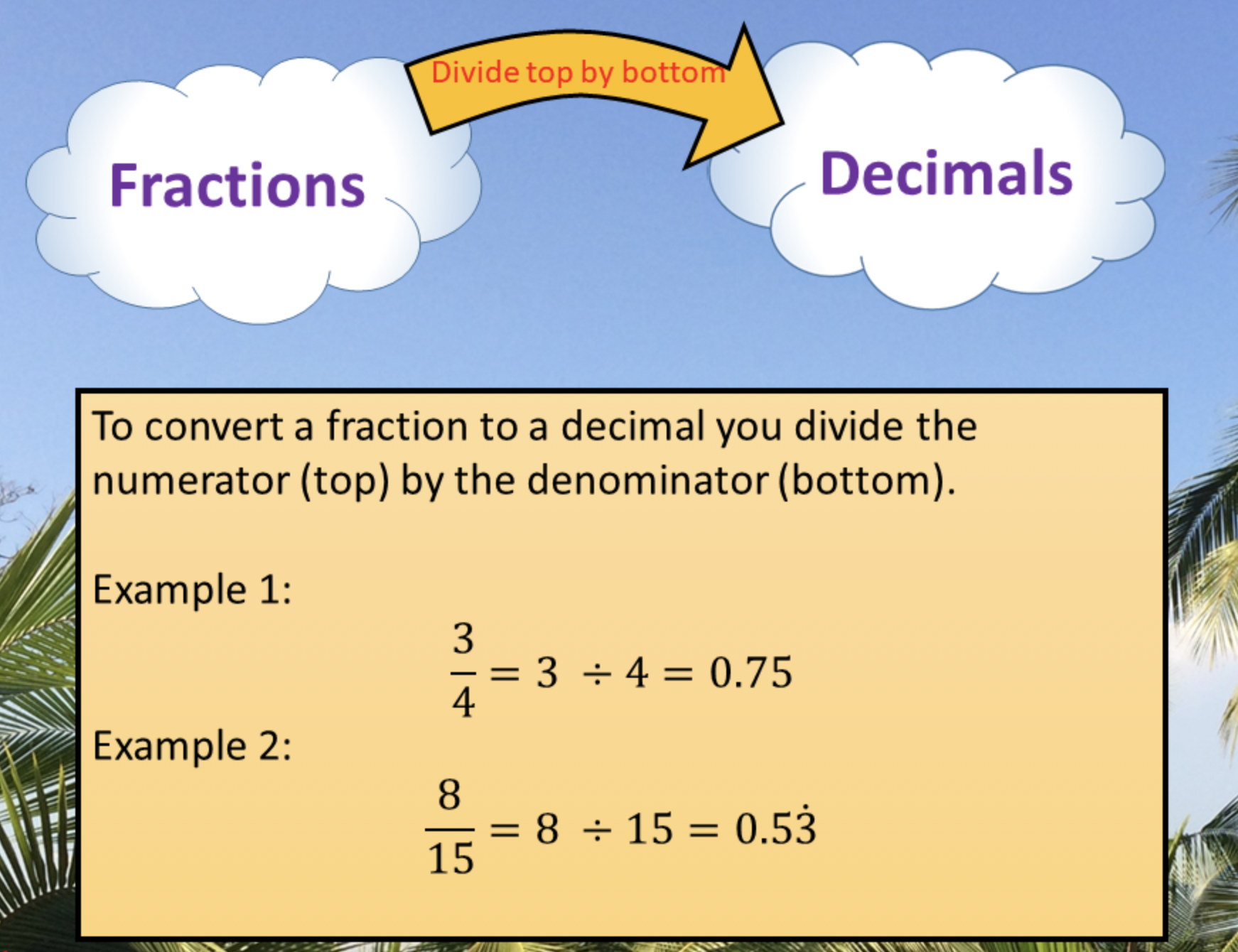
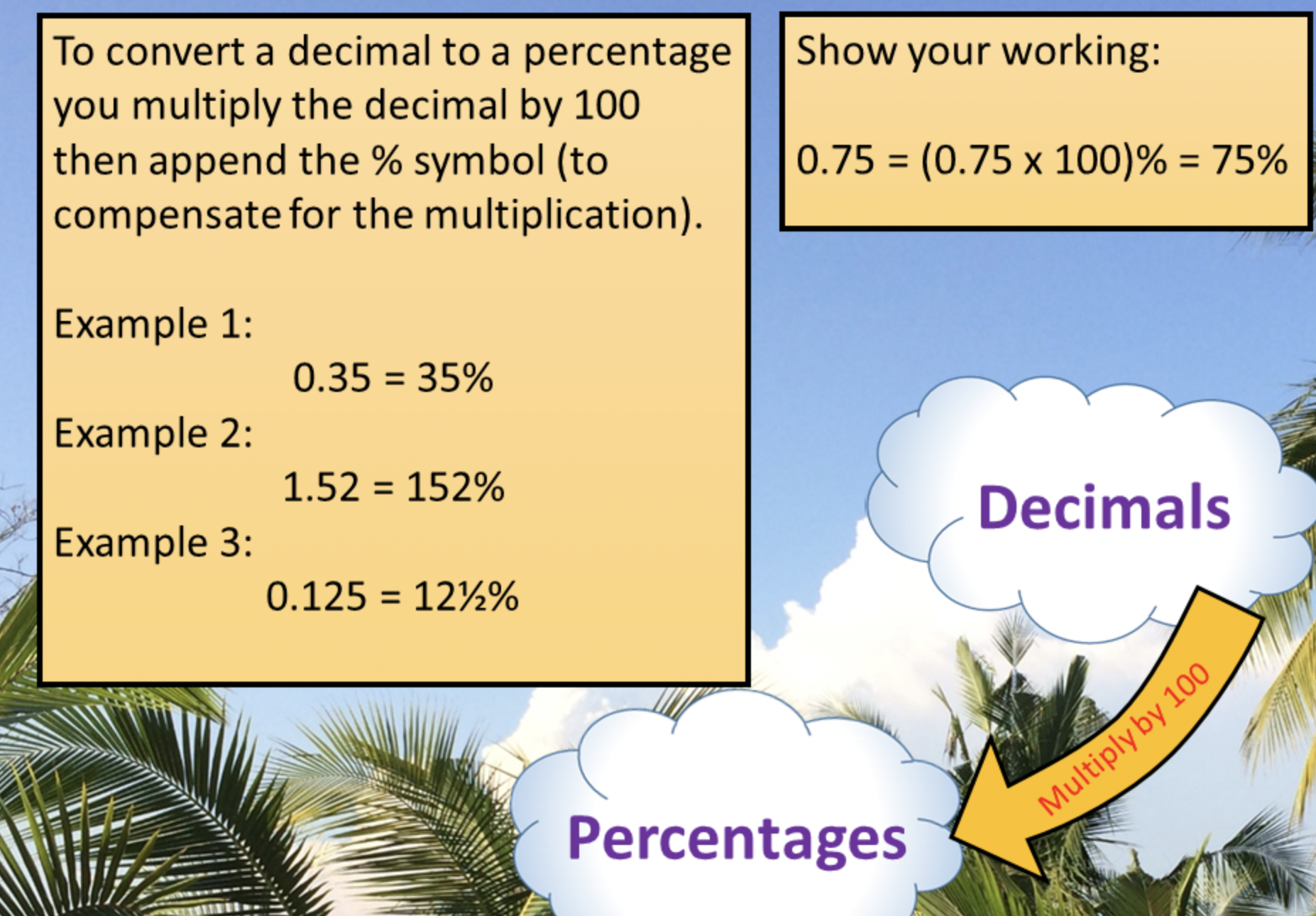
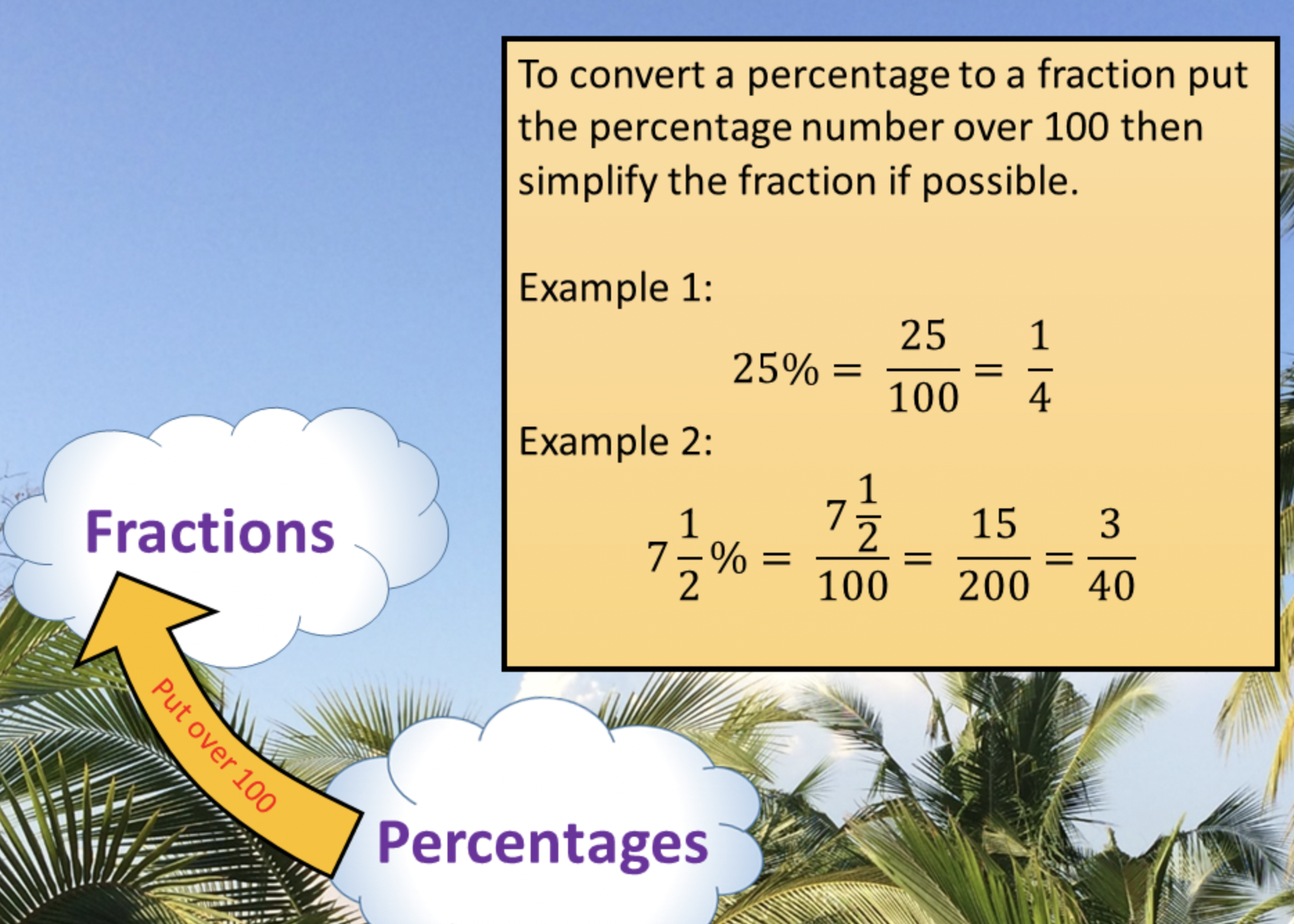

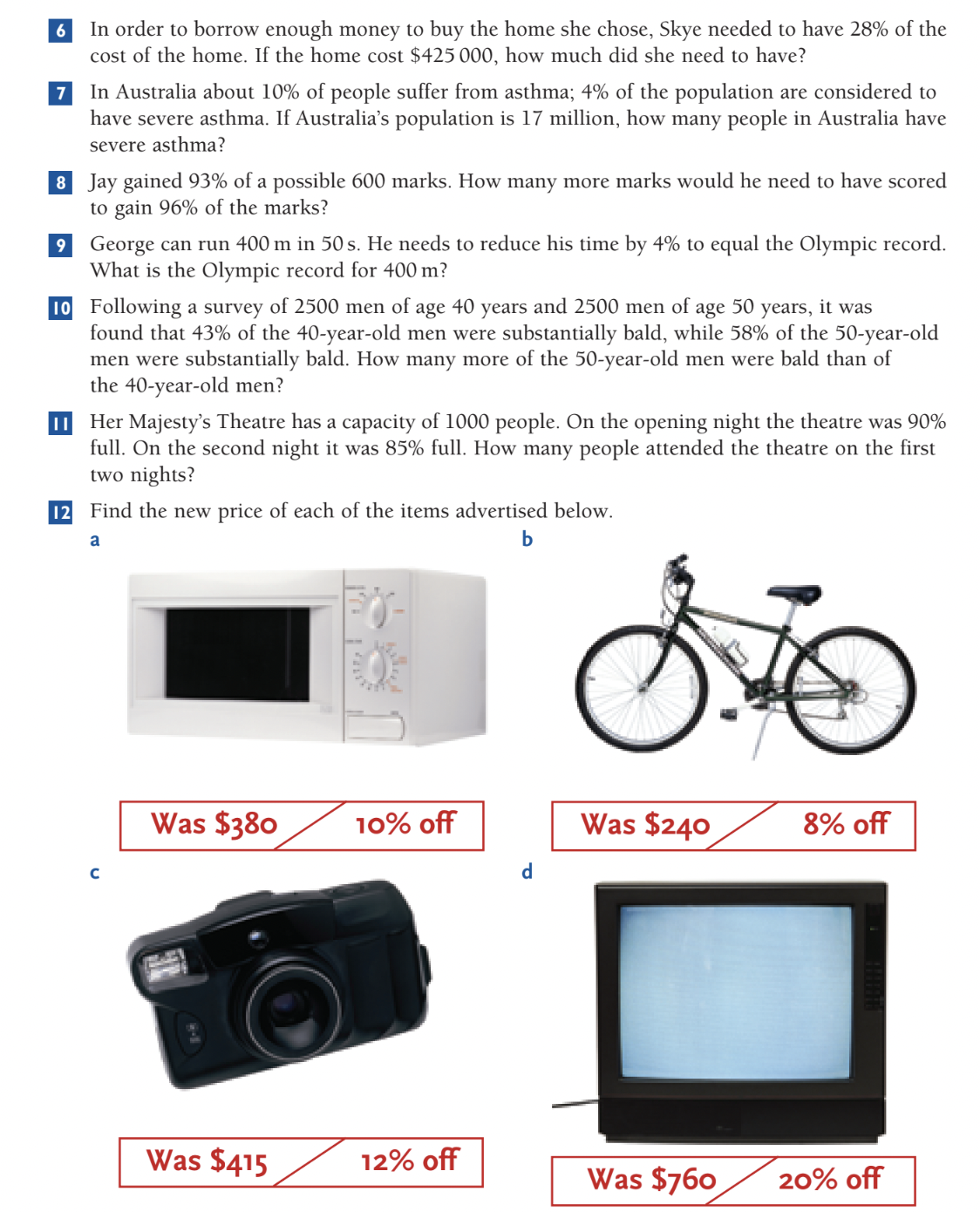
-
Kia ora 8C1
TERM 1 WEEK 5
Success Criteria: I can/have...
- Arrange integers in ascending and descending order
- Add and subtract integers
- Understand and use the correct order of operations
Activities:
- Warm up activity
- Explanation of skills and concepts with examples (Whole class, group or individual teaching as required)
- Integers Video - https://www.youtube.com/watch?v=7XCh1b63xd4
- Practice questions (Differentiation)
- Contextual problem solving (Extension)
- Applications (Extension) (Page page 53 Alpha Maths)
Please go to Google Classroom for this week's tasks
Homework:
Maths Buddy (Differentiation)
EXPLORE / TŪHURA learning intentions:
- We are EXPLORING operations on and calculations with integers and order of operations.
NOTES:
The order of operations is:
- Parentheses: Perform any calculations inside parentheses first.
- Exponents: Evaluate any exponents, such as 2^3, next.
- Multiplication and Division: Perform multiplication and division operations from left to right.
- Addition and Subtraction: Perform addition and subtraction operations from left to right.
-
Kia ora 8C1
TERM 1 WEEK 6
This week I will be on Camp for Thursday and Friday's lessons.
Please find Tasks on Google Classroom as well as on Education Perfect. Email me any questions and I can go over them in Week 7
Success Criteria: I can/have...
- Round numbers sensibly
- Use multiplicative strategies
- Identify factors and multiples of natural numbers
Activities:
- Maori numbers - 1 - 30
- Warm up task - Numeracy Ninja
- Explanation of skills and concepts (rounding, factors and multiples) with examples
- Video on Rounding numbers - https://www.youtube.com/watch?v=fd-E18EqSVk (Please start watching video from 6.10mins onwards)
- Online practice rounding numbers - https://www.abcya.com/games/rounding_numbers
- Multiplying by tens, hundreds and thousands/A bit more/less
- Education Perfect task
- Multiplication word problems - https://www.transum.org/Maths/Activity/Multi-step/
- Practice questions (Differentiated) on Google Classroom
- Extension - Contextual applications
Homework:
Maths Buddy (Differentiation)FOCUS / ARONGA learning intentions:
- We are FOCUSING on rounding numbers to make sensible estimates.
EXPLORE / TŪHURA learning intentions:
- We are EXPLORING finding factors, multiples and prime factors of numbers.
- We are EXPLORING different multiplicative strategies
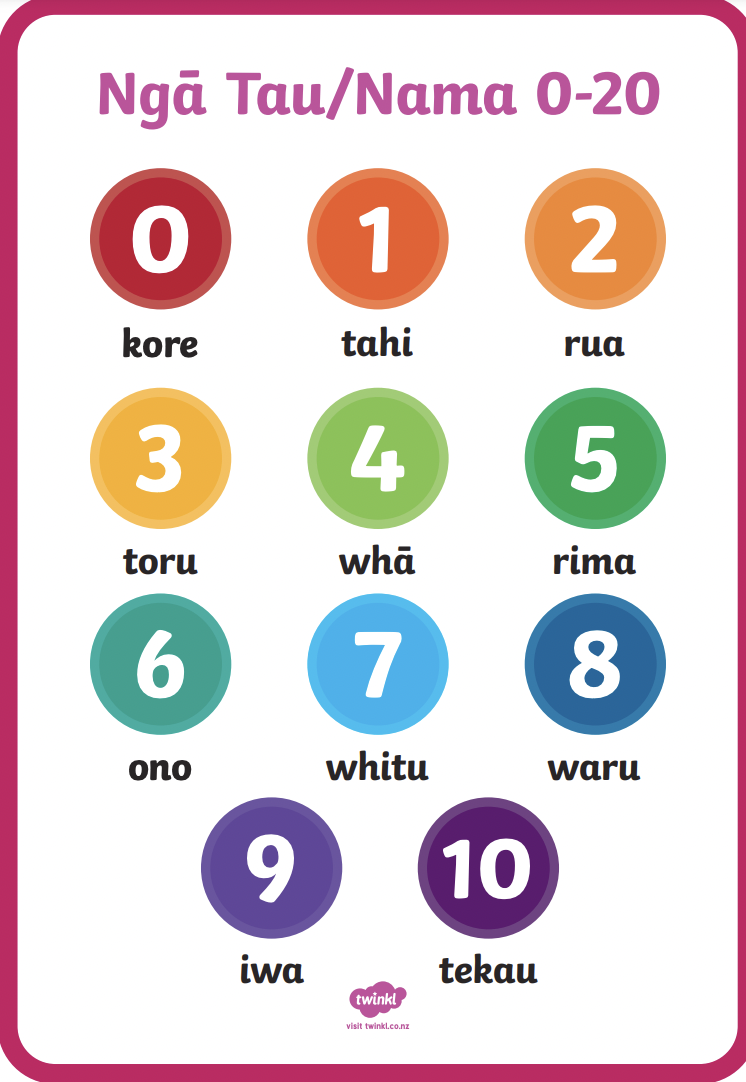

-
Kia ora 8C1
TERM 1 WEEK 7
Success Criteria: I can/have...
- Convert confidently between fractions, decimals and percentages
- Express quantities as fractions, decimals and percentages of a whole
- Find a given percentage of a quantity
Activities:
- Warm up
- Finding a percentage of an amount/quantity
- Quantities as percentage of other quantities
- Matching common percentages to fraction equivalents
- Converting between common fractions, decimals and percentages
- Practice task on EP (Differentiation)
- Contextual applications of percentages (Extension)
Homework:
Maths Buddy (Differentiation)
EXPLORE / TŪHURA learning intentions:
- We are EXPLORING finding ways to express a fraction and a decimal as a percentage and vice versa.
- We are EXPLORING calculating a given percentage of a quantity
-
Kia ora 8C1
TERM 1 WEEK 8
Success Criteria: I can/have...
- Operate with ratios
- Solve contextual problems involving fractions, decimals and percentages
- Attempted the practise test
Activities:
- Do Now - Numeracy Ninja
- Revision of fraction, decimals and percentages skills
- Introduce ratios
- Assessment revision slides
- Practise test
- Writing ratios - https://www.transum.org/Software/SW/Starter_of_the_day/Students/Ratio.asp
Homework:
Maths Buddy
PLAN & DO / WHAKAMAHI learning intentions:
- We are PLANNING to apply our knowledge of fractions, decimals and percentages to solve skill based and contextual problems.
-
Kia ora 8C1
TERM 1 WEEK 9
Success Criteria: I can/have...
- Operate with fractions, decimals, percentages and ratios
- Completed the EP Assessment on Thursday
- Reviewed the Assessment Review Slides on GC
Activities:
- Numeracy Ninja Do Now
- Revision of skills involving fractions, decimals and percentages
- Reteaching and reinforcement of skills where required
- Tasks for consolidation of skills
- Assessment on EP on Thursday
Homework:
Maths BuddyREFLECT / WHAIWHAKAARO learning intentions:
- We are REFLECTING on our number skills by reviewing our knowledge of fractions, decimals and percentages.
-
Kia ora 8C1
TERM 1 WEEK 10
Success Criteria: I can/have...
- Explore the uses of measurement in work, sport, at home and in leisure
- Select appropriate units of measure
- Make conversions between units of measure
Activities:
- Warm up - Numeracy Ninja
- Introduction: BrainPop Video on Metric system
- What are some things that we measure/see or know are measured in day to day life? How do we measure these?
- What kind of things did people use for measuring in old times? Were these measurements accurate? Why not?
- What are some units of measurement we use nowadays? Are these accurate? What makes them accurate?
- Units of measurement - https://www.transum.org/Maths/Activity/Units/Default.asp?Level=1
- Units for measuring length and mass - Standardised units - The Metric System
- Conversion factors - Copy in books
- Can we convert one unit into another? Can you think of ways to do that?

- Skill Practice (Differentiation) - GC Worksheet
Homework:
Maths Buddy (Differentiation)
EXPLORE / TŪHURA learning intentions:
- We are EXPLORING uses and units of measurement
FOCUS / ARONGA learning intentions:
- We are FOCUSING on developing an understanding of how to convert between measurement units
-
TERM HOLIDAYS
-
Kia ora 8C1
TERM 2 WEEK 1 and 2
Success Criteria: I can/have...
- Explore uses of measurement
- Select appropriate units to measure things
- Make conversions between units of measurement
Activities:
- Warm up - https://www.transum.org/Maths/Activity/Units/Default.asp?Level=1
- What is capacity?
- Units for capacity measurement - Take notes from the board
- Apply knowledge of conversions to units of volume
- Problem solving involving units of measurement - Teacher explanation with examples
- Skill Practice -(Differentiated tasks)
- Relationship between volume, capacity and mass (Extension)
- Online practice for volume, capacity and mass (Extension) - https://www.transum.org/Maths/Activity/Units/Default.asp?Level=3

Homework:
Maths Buddy (Differentiation)
EXPLORE / TŪHURA learning intentions:
- We are EXPLORING uses and units of measurement.
FOCUS / ARONGA learning intentions:
- We are FOCUSING on developing an understanding of how to convert between measurement units
- We are FOCUSING on solving measurement problems in context
-
Kia ora 8C1
TERM 2 WEEK 3
Success Criteria: I can/have...
- Calculate the perimeters of polygons and circles
- State and use the formulae for areas of polygons and circles
Activities:
- Warm up - https://www.transum.org/software/SW/polygons/polygons.asp
- What is perimeter? - Distance around the boundary of a figure
- How to calculate the perimeter of regular and irregular polygons
- Perimeter of circles - Can you think of a way to find the distance around a circle?
- Using a formula to find the perimeter of a circle
- What is area? - Amount of surface within a 2 dimensional shape
- Unit of area - square cm or m
- How to calculate areas of triangles, rectangles and squares ( Group work)
- Online practice for Area of rectangles - https://www.transum.org/Software/SW/Starter_of_the_day/students/Oblongs.asp
- Practice questions (Differentiated)
Homework:
Maths Buddy (Differentiated)
EXPLORE / TŪHURA learning intentions:
- We are EXPLORING uses and units of measurement.
- We are EXPLORING different ways to measure perimeter and area
- We are EXPLORING how to use formulae to find perimeters and areas of shapes
-
Kia ora 8C1
Success Criteria: I can/have...
- Read scales from different practical situations
- Select appropriate units for measuring time and calculate time differences
- Discuss the difference between 12 and 24 hour time
- Read and interpret 24 hour clocks
Activities:
- Warm up - Numeracy Ninja
- https://www.transum.org/Maths/Activity/Time/Months.asp
- Discuss uses of time measure in work, sport, leisure etc
- History of the calendar (Systems)
- Telling the time - https://www.transum.org/Maths/Activity/Time/
- What are the units of time and their relationship
- Converting from one unit into another
- Reading Tmetables - https://www.transum.org/Maths/Exercise/Timetables.asp
- Reading 24 hour clocks - 4 digit notation
- Solving time measurement problems in context
- Education Perfect
Homework:
Maths Buddy
EXPLORE / TŪHURA learning intentions:
- We are EXPLORING uses and units of measurement.
- We are EXPLORING reading scales to the nearest graduation
PLAN & DO / WHAKAMAHI learning intentions:
- We are PLANNING to perform calculations with time including 24 hour time so that we can solve problems in context

-
Kia ora 8C1
TERM 2 WEEK 5
Success Criteria: I can/have...
- Use appropriate units for measurement involving Area and Volume
- Find volume of cuboids from measurements of length
Activities:
- Warm up - Numeracy Ninja Do Now
- Reading scales - https://www.transum.org/Maths/Activity/Reading_Scales/Default.asp?Level=1
- Reading temperature - https://www.transum.org/Software/SW/Starter_of_the_day/students/Temperature.asp
- Difference between 2D and 3D objects
- What is volume? What is it measured in?
- Explain with example of dividing a cuboid into square units - counting them - work with manipulates
- Coming up with the formula of volume - lxbxh
- https://www.brainpop.com/math/geometryandmeasurement/volumeofprisms/movie
- https://www.brainpop.com/math/geometryandmeasurement/volumeofcylinders/movie
- Using the formula to find volume
- Online practice for volume - https://www.transum.org/Software/SW/Starter_of_the_day/Students/Volume.asp?Level=1
- Practice questions(Differentiated)
- Contextual problems - Extension
Homework:
Maths Buddy (Differentiation)
Education Perfect
EXPLORE / TŪHURA learning intentions:
- We are EXPLORING reading scales to the nearest graduation
- We are EXPLORING calculating the volume of cuboids

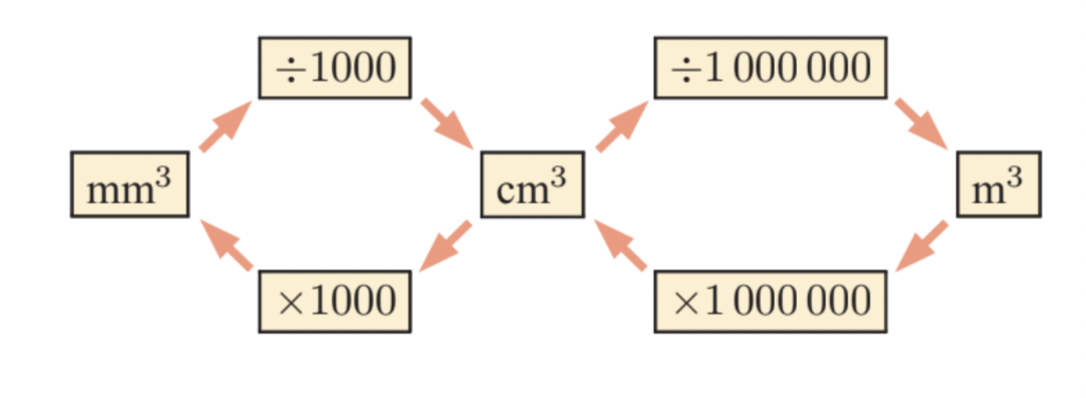

-
FOCUS / ARONGA learning intentions:
- We are FOCUSING on modelling and describing 3D objects illustrated by diagrams or pictures
EXPLORE / TŪHURA learning intentions:
We are EXPLORING 2D AND 3D shapes
Kia ora 8C1
TERM 2 WEEK 6Success Criteria: I can/have...
- Identify 2D and 3D shapes
- Draw common solids
- Identify faces, vertices and edges of regular and irregular polygons and solids
Activities:
- Warm up - Numeracy Ninja https://www.transum.org/software/Online_Exercise/ShapesInTheStars/
- What are polygons?
- Regular and Irregular polygons - Discussion what the word regular and irregular suggest
- Online practice - https://www.transum.org/Software/Online_Exercise/PolygonProperties/
- What is a solid object? Look at some examples of solids
- Draw shapes of common solids in books
- Describing a polygon or solid using faces, vertices and edges - https://www.transum.org/software/SW/Starter_of_the_day/Students/FacesEdges.asp?Level=1
- Difference between a prism and a pyramid
- Constructing solids from their nets
Homework:
Maths Buddy (Differentiation)
-
EXPLORE / TŪHURA learning intentions:
- We are EXPLORING recognising symmetry in patterns, objects and figures
FOCUS / ARONGA learning intentions:
- We are FOCUSING on describing the reflection and rotational symmetry of a figure
- We are FOCUSING on describing the transformations in patterns
Kia ora 8C1
TERM 2 WEEK 7
Success Criteria: I can/have...
- Describe symmetry in patterns, objects and designs
- Explore translation, reflection and rotation in patterns, objects and designs
Activities:
- Warm up - https://www.transum.org/Software/SW/Starter_of_the_day/starter_May26.ASP
- What is symmetry?
- Lines of symmetry/Reflection symmetry - Demonstrate with cut outs
- EP Task
- Online practice reflection - https://www.transum.org/software/SW/Starter_of_the_day/Students/Transformations/Draw.asp?Level=1
- What is point symmetry and rotational symmetry - 90, 180, 270 and 360 degrees turn, clockwise, anticlockwise - Demonstrate with cut outs
- Practical activities to understand reflection, rotation and translation
- Identifying transformations in patterns
Homework:
Maths Buddy(Differentiation)
-
FOCUS / ARONGA learning intentions:
- We are FOCUSING on describing the reflection and rotational symmetry of a figure
- We are FOCUSING on describing the transformations in patterns
EXPLORE / TŪHURA learning intentions:
- We are EXPLORING recognising symmetry in patterns, objects and figures
Kia ora 8C1
TERM 2 WK 8
Success Criteria: I can/have..
- Describe symmetry in patterns, objects and designs
- Explore translation, reflection and rotation in patterns, objects and designs
Activities:
- Warm up - Numeracy Ninja
- https://www.transum.org/software/SW/Starter_of_the_day/Students/Transformations/Draw.asp
- https://www.brainpop.com/math/geometryandmeasurement/transformation/
- Looking at patterns involving transformations
- Identifying transformations in patterns -
- Queries/questions
Homework:
Maths Buddy(Differentiation)
-
PLAN & DO / WHAKAMAHI learning intentions:
- We are PLANNING to create a pattern so that we can construct a symmetrical design using the pattern.
- We are PLANNING to write a discussion so that we can demonstrate our knowledge of the geometrical concepts used in our design.
Kia ora 8C1
TERM 2 WEEK 9
Success Criteria: I can/have...
- Describe symmetry using the concept of reflection, rotation and translation in patterns, objects and designs
Activities:
- Warm up - Numeracy Ninja
- https://www.hoodamath.com/games/walkthroughs/transformationgolf.html
- Recap of transformations - reflection, rotation and translation
- Recognising symmetry in patterns
- Introduce assessment
- Go over rubric
- Explain how to attempt assessment - Go over exemplar
- Describing symmetry using geometrical concepts (refer to exemplar)
- Start creating the basic pattern and a design using the basic pattern
Homework:
Work on assessment
-
PLAN & DO / WHAKAMAHI learning intentions:
- We are PLANNING to create a pattern so that we can construct a symmetrical design using the pattern.
- We are PLANNING to write a discussion so that we can demonstrate our knowledge of the geometrical concepts used in our design.
Kia ora 8C1
TERM 2 WEEK 9
Success Criteria: I can/have...
- Describe symmetry using the concept of reflection, rotation and translation in patterns, objects and designs
Activities:
- Recap of transformations - reflection, rotation and translation
- Recognising symmetry in patterns
- Continue working on assessment
- Go over rubric
- Explain how to attempt assessment - Go over exemplar
- Describing symmetry using geometrical concepts (refer to exemplar)
- Continue creating the basic pattern and a design using the basic pattern
Homework:
Work on assessment
-
TERM HOLIDAYS
-
EXPLORE / TŪHURA learning intentions:
- We are EXPLORING continuing number and spatial patterns
- We are EXPLORING finding and using a rule to make predictions
FOCUS / ARONGA learning intentions:
- We are FOCUSING on describing in words, rules for continuing number and spatial patterns
Kia ora 8C1
Success Criteria: I can/have...
- Continue a number pattern and write a rule in words to describe the pattern
- Continue a spatial pattern, make up and use a rule to describe the spatial pattern
- SUBMIT YOUR ASSESSMENT BY MONDAY 17TH JULY 3PM
Activities:
- Warm up - https://www.transum.org/software/SW/Starter_of_the_day/Students/Missing_Terms.asp?Level=1
- https://www.transum.org/Software/SW/Starter_of_the_day/Students/Coordinates.asp
- Looking at number sequences
- Introduce number plane - Horizontal and vertical axis
- Writing coordinates and locating points on a number plane
- Describing number sequence rules in words
- Writing a number sequence using a rule
- Number crunching machines - use the rule to find the missing numbers
- Online practice for function machines - https://www.transum.org/Maths/Puzzles/Les_Page/Brainbox/Default.asp?Level=1
- Practice questions
- Numeracy Certificate
Homework:
Maths Buddy (Differentiation)
-
EXPLORE / TŪHURA learning intentions:
- We are EXPLORING continuing number and spatial patterns
- We are EXPLORING finding and using a rule to make predictions
FOCUS / ARONGA learning intentions:
- We are FOCUSING on describing in words, rules for continuing number and spatial patterns
Kia ora 8C1
Success Criteria: I can/have...
- Continue a spatial/geometric pattern, make up and use a rule to describe the sequence
- Use a rule to make predictions
Activities:
- Warm up - https://www.transum.org/Software/SW/Starter_of_the_day/starter_January26.ASP
- What are geometric patterns?
- How to continue a geometric pattern
- Constructing a table for a geometric pattern
- Writing a rule to describe the pattern using values from the table
- Using the rule to make a prediction (Extension)
- Practice questions for each of the above skills
- Education Perfect: Patterns and Relationships
Homework:
Maths Buddy, Education Perfect
-
EXPLORE / TŪHURA learning intentions:
- We are EXPLORING continuing number and spatial patterns
- We are EXPLORING finding and using a rule to make predictions
- We are EXPLORING interpreting algebraic vocabulary and conventions
Kia ora 8C1
Success Criteria: I can/have...
- Continue a spatial/geometric pattern, make up and use a rule to describe the sequence
- Use a rule to make predictions
- Understand algebraic vocabulary and conventions
Activities:
- Warm up - https://www.transum.org/Maths/Activity/Matchstick_Patterns/
- What is Algebra? - Introduction to algebraic vocabulary and conventions
- Writing an algebraic expressions from a structured situation presented with images
- Form an algebraic expression from a situation using images to represent physical quantities (in pairs)
- Introduce like terms as a follow on from previous activity
- EP task on identifying like terms
- Practice questions
- Combining like terms - Extension
Homework:
Maths Buddy (Differentiation)
-
EXPLORE / TŪHURA learning intentions:
- We are EXPLORING finding and using a rule to make predictions
- We are EXPLORING interpreting algebraic vocabulary and conventions
- We are EXPLORING like terms through using physical quantities to conceptualise the idea
- We are EXPLORING collecting and adding like terms to simplify algebraic expressions
Kia ora 8C1
Success Criteria: I can/have...
- Identify like terms
- Add and subtract simple like terms
- Write sums as products in Algebraic form
Activities:
- Warm up
- Recap of last week's activities on GC
- Combining and writing like terms together
- Adding and subtracting simple like terms
- EP Task
- Writing sum of the same variables as products - product rotation summary - see tasks below
- Extension - Alpha book - Pg 183 and 184
Homework:
Maths Buddy (Differentiation)
-
EXPLORE / TŪHURA learning intentions:
- We are EXPLORING experimenting with balancing scales to solve simple equations
FOCUS / ARONGA learning intentions:
- We are FOCUSING on solving simple equations
Kia ora 8C1
Success Criteria: I can/have...
- Understand the concept of balance in an equation
- Solve simple equations
Activities:
- Warm up - https://www.transum.org/Maths/Puzzles/Scouts/Boats/?Level=1
- Finding weights by balancing - https://www.roomrecess.com/Tools/PanBalance/play.html
- Balancing scales - https://www.pbslearningmedia.org/resource/mgbh.math.ee.balance/balancing-scales-to-solve-equations/
- What is an equation? - number statements with an equal sign
- Understanding what balancing means
- GC Activity
- Online activity stable scales - https://www.transum.org/software/SW/Starter_of_the_day/Students/Stable_Scales_Quiz.asp
- Applying the concept of balance in maths - either side of the equal sign should be balanced
- Introducing simple equations with variables - Conceptualise by creating scenarios around algebraic equations
- How to solve a simple equation involving variables
- Practice questions
- Extension - Alpha book -
Homework:
Maths Buddy (Differentiated)
-
EXPLORE / TŪHURA learning intentions:
- We are EXPLORING experimenting with balancing scales to solve simple equations
FOCUS / ARONGA learning intentions:
- We are FOCUSING on solving simple equations
EXPLORE / TŪHURA learning intentions:
- We are EXPLORING interpreting graphs of real life situations
FOCUS / ARONGA learning intentions:
- We are FOCUSING on explaining graphs of real life situations.
Kia ora 8C1
Success Criteria: I can/have...
- Understand the concept of balance in an equation
- Solve simple equations
- an understanding of graphs
Activities:
- Warm up - https://www.transum.org/software/River_Crossing/
- Finding weights by balancing - https://www.roomrecess.com/Tools/PanBalance/play.html
- Balancing scales - https://www.pbslearningmedia.org/resource/mgbh.math.ee.balance/balancing-scales-to-solve-equations/
- What is an equation? - number statements with an equal sign
- Understanding what balancing means
- Scales activity to understand balance
- Online activity stable scales - https://www.transum.org/software/SW/Starter_of_the_day/Students/Stable_Scales_Quiz.asp
- Applying the concept of balance in maths - either side of the equal sign should be balanced
- Introducing simple equations with variables - Conceptualise by creating scenarios around algebraic equations
- How to solve a simple equation involving variables
- Algebra Escape Room on GC
- Maori Legend Algebraic Expressions
- Introducing graphs and their meaning
Homework:
Maths Buddy (Differentiation)
-
EXPLORE / TŪHURA learning intentions:
- We are EXPLORING interpreting graphs of real life situations
FOCUS / ARONGA learning intentions:
- We are FOCUSING on explaining graphs of real life situations.
Kia ora 8C1
Success Criteria: I can/have...
- Sketch and interpret graphs which represent simple everyday situations
Activities:
- Warm up - https://www.transum.org/Maths/Game/Darts/
- Graphs - What do graphs show? Record responses from class on the board
- Looking at family relationships graphs and time and distance graphs
- Online practice - https://www.transum.org/Maths/Activity/Scatter_Graphs/Cartoon.asp
- Children answer questions as prompts for interpreting graphs
- Graph as as a picture of what is happening
- Show example of a graph with a scenario and invite students to interpret what they think is happening/what the graph is showing/The story the graph is telling
- Teacher gives own interpretation - Class can critique if they don't agree with a certain part
- Practice questions(Differentiated)
Homework:
Maths Buddy(Differentiated) -
EXPLORE / TŪHURA learning intentions:
- We are EXPLORING interpreting graphs of real life situations
FOCUS / ARONGA learning intentions:
- We are FOCUSING on explaining graphs of real life situations.
Kia ora 8C1
Success Criteria: I can/have...
- Sketch and interpret graphs which represent simple everyday situations.
Activities:
- Warm up - https://www.transum.org/Software/Fun_Maths/23orBust.asp
- Graphs - What do graphs show? Record responses from class on the board
- Looking at family relationships graphs and time and distance graphs
- Children answer questions as prompts for interpreting graphs
- Graph as as a picture of what is happening
- Show example of a graph with a scenario and invite students to interpret what they think is happening/what the graph is showing/The story the graph is telling - Literacy in Maths
- Teacher gives own interpretation - Class can critique if they don't agree with a certain part
- Practice questions(Differentiated)
Homework:
Maths Buddy (Differentiation)
-
FOCUS / ARONGA learning intentions:
- We are FOCUSING on discussing what jobs can students do to earn money
EXPLORE / TŪHURA learning intentions:
- We are EXPLORING calculating hourly wages
Kia ora 8C1
Success Criteria: I can/have...
- Define what earning means
- Understand the meaning of hourly rate
- Made progress with the Numeracy Certificate
Activities:
- Warm up - https://www.transum.org/software/SW/Starter_of_the_day/Students/MoneyMaths.asp
- How to write per as in $/hour and what it means
- How to calculate earnings for certain hours given the hourly rate
- Earnings = hours x $/hour
- Working half hours
- Introduction to money time - log in and watch introductory video
- Start Module 1
Homework:
Maths Buddy weekly revision task
Money Time modules
-
FOCUS / ARONGA learning intentions:
- We are FOCUSING on discussing what jobs can students do to earn money
- We are FOCUSING on developing an understanding of savings and earning interest on savings
Kia ora 8C1
Success Criteria: I can/have...
- Understand what does saving mean
- Know what is interest and how to earn it on savings
- made progress in my Numeracy Certificate
Activities:
- Warm up
- How can you save - opening a savings account
- Regular money contributions into the account
- Earning interest on the money in the savings account
- Difference between regular savings account and everyday account
- Work on module 2 and 3 - Savings and interest
Homework:
Complete Money time Modules
Complete Numeracy Certificate
-
TERM HOLIDAYS
-
TERM HOLIDAYS
-
Kia ora 8C1
TERM 4 WEEK 1
Success Criteria: I can/have...
- Maths Buddy Revision Tasks completed
- Education Perfect Task completed by end of next week
- Maths Buddy Numeracy Certificate - continue making progress
- Money Time - continue completing modules
Activities:
- Warm up - Money time module
- Maths Buddy Revision Tasks
- Maths Buddy Numeracy Certificate
- EP Task
- Extension: Graph tasks below
Homework:
Maths Buddy (Differentiated)
-
Kia ora 8C1
TERM 4 WEEK 2
TERM 4 WEEK 1
Success Criteria: I can/have...
- Maths Buddy Revision Tasks completed
- Education Perfect Task completed by end of this week
- Maths Buddy Numeracy Certificate - continue making progress
- Money Time - continue completing modules
Activities:
- Warm up - Money time module
- Maths Buddy Revision Tasks
- Maths Buddy Numeracy Certificate
- EP Task
- Extension: Frequency Table activity below
Homework:
Maths Buddy (Differentiated)
-
EXPLORE / TŪHURA learning intentions:
- We are EXPLORING statistical literacy and recognising statistical words, terms and their meanings
- We are EXPLORING recognising and finding features of data display
Kia ora 8C1
TERM 4 WEEK 3
Success Criteria: I can/have...
- Find the mean, mode and median for a given data set
Activities:
- Warm up - Money time module
- What is an average? Introduce the term mean - vocabulary
- One way of finding an average in statistics is to calculate the mean (the average of a set of scores)
- Start with the mean of two numbers, then three, then 4 - Students to pick up the method - Add scores and divide by how many there are
- Other measures of the middle of a set of scores are mode and median
- Finding the mode and median
- Practice questions (Differentiated)
Homework:
Maths Buddy(Differentiation)
-
Success Criteria: I can/have...
- Display data in dot plots and stem and leaf graphs
Activities:
- Warm up - Money time modules
- Online practice for averages - https://www.transum.org/software/SW/Starter_of_the_day/Students/Averages.asp?Level=1
- What do you understand by a dot plot in statistics? What does the name suggest?
- Example of dot plot on board. What do you think each dot represents - How to read a dot plot
- How to make a dot plot - Teacher demonstrates on board with an example
- Usage of dot plots - To record large numbers of numerical values in an organised and easy to see/infer way
- Practice questions
- Extension - Working out fractions and percentages from dot plots and answer simple analytical questions
Homework:
Maths Buddy(Differentiated)
-
EXPLORE / TŪHURA learning intentions:
- We are EXPLORING collecting and displaying discrete numerical data in dot plots and stem and leaf graphs
Kia ora 8C1
TERM 4 WEEK 5
Success Criteria: I can/have...
- Display data in dot plots and stem and leaf graphs
Activities:
- Warm up - Money time module - Business
- Online practice for dot plots - https://www.khanacademy.org/math/cc-sixth-grade-math/cc-6th-data-statistics/dot-plot/e/creating-dot-plots
- Introduce vocabulary around stem and leaf graphs - what kind of graph does the name suggest? Use your imagination - Discuss in groups
- Introduce structure of a stem and leaf graph - Can you identify which part of the graph is the stem and what part is leaves?
- Go back to data set and graph - Can you figure out how is a stem and leaf graph constructed from a data set
- On the board show how to construct a stem and leaf graph step by step from a data set
- Video - https://www.youtube.com/watch?v=dXwmd-98uFM
- Practice questions for e asttle for Week 6 on GC
- Extension - Finding the mean, mode, median and range from a stem and leaf graph
Homework:
Maths Buddy(Differentiaton)
-
EXPLORE / TŪHURA learning intentions:
- We are EXPLORING interpreting time series graphs
- We are EXPLORING displaying time series data in a line graph
Kia ora 8C1
Success Criteria: I can/have...
- Read and interpret time series graphs
- Display time series data on a appropriate graph
Activities:
- Money time module - Business
- What is a time series graph?
- How to plot a time series graph
- Reading and interpreting a time series graph - T explains with an example
- Practice questions
- Online practice for line graph - https://www.mathsisfun.com/data/line-graphs.html
- Extension - Reading time series graphs with two variables
Homework:
Maths Buddy(Differentiation)
-
EXPLORE / TŪHURA learning intention:
- We are EXPLORING presenting discrete data in a pie graph.
- We are EXPLORING interpreting pie graphs.
Kia ora 8C1
Success Criteria: I can/have...
- Interpret information from a pie graph
- decimal review (multiplication, ranking...)
Activities:
- Warm up - money time modules
- What are pie graphs? What does the name suggest?
- Dividing a circle into sectors (pies)
- Interpreting information from a pie chart - Explain with example
- EP task on pie graphs
- Practice questions
- Extension - Constructing a pie chart
Homework:
Maths Buddy (Differentiation) -
Kia ora...
Success Criteria: I can/have...
- a good understanding of decimal addition, subtraction and multipplication
Activities:
- Numeracy Certificate
- Maths Buddy Revision Task'
- GC decimal task
- Education Perfect task on Decimals

